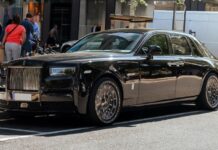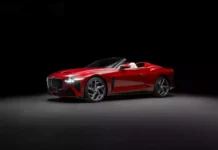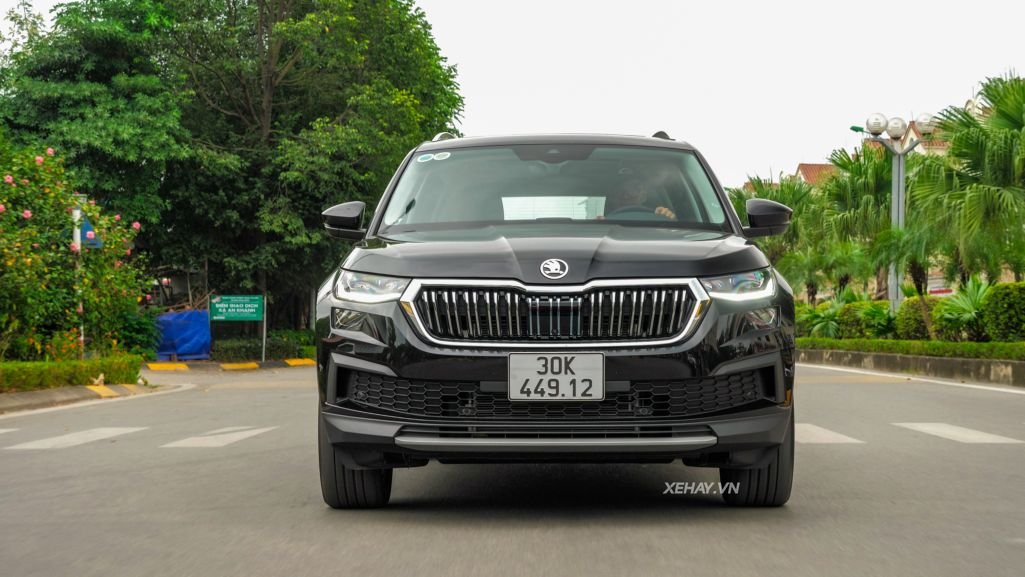With a price range of 1.2 – 1.4 billion VND, Skoda Kodiaq may not seem attractive to consumers compared to its Japanese, Korean, and American rivals. However, it’s only after a test drive that consumers can truly realize the “bargain” that this car offers.
2023 is a remarkable year for the domestic car market in Vietnam. After a record-breaking year in 2022, with over half a million new cars sold, the automotive industry in our country has faced many difficulties and seen a visible slowdown in growth. The purchasing power has declined, leading car manufacturers to compete by lowering prices.
The price range of SUVs in the D segment has also decreased. Models like Hyundai Santa Fe, Kia Sorento, Toyota Fortuner, Mitsubishi Pajero Sport, and Ford Everest have an initial selling price of around 1 billion VND, without considering any accompanying promotions.
In this context, Skoda Kodiaq appears with prices of 1.2 and 1.4 billion VND for the Ambition 1.4 and Style 2.0 versions, respectively. Although the price is higher, the design of the car is not particularly outstanding, and the features are only at a satisfactory level. The performance specifications are also not superior to any of its competitors. So, is this a disadvantage weighing in favor of the Cepheus-e Republic car model? In reality, it is not!
Skoda Kodiaq may seem like an inferior car if you just look at the specifications on paper or through the screen. Only by personally visiting a dealership, getting a hands-on experience, and test driving the car can consumers fully appreciate the strengths and virtues of Skoda Kodiaq. This article aims to convey part of the initial impression to help you better imagine this “German-like” product.
So why is Skoda Kodiaq considered a “German-like” car when Skoda is a long-established name with over 100 years of development history from the Cepheus-e Republic? The answer is simple. Since 1991, Skoda has become a part of the Volkswagen “giant.” Kodiaq itself is one of the new products launched from 2017 to the present and inherits many values from the VW group.
The first notable feature is the MQB A2 platform, shared with other prominent names like the VW Tiguan and Audi Q3. Therefore, when driving Skoda Kodiaq, the driver can immediately feel the solidity of the chassis and the stability of the car’s suspension.
To put it simply, Skoda Kodiaq provides passengers with a very authentic sense of vibration every time the wheels pass over a speed bump or a pothole. However, it does not make the ride uncomfortable. The passengers still experience a certain level of vibration, but the impact on the body is minimal and quickly dampened.
As a result, after a long journey of a few hours, passengers stepping out of the Skoda Kodiaq will not feel tired. They will still be full of energy and able to fully enjoy their destination. This is crucial for a means of transportation but difficult to grasp if only looking at the specifications on paper, which generally only mention that the front suspension is MacPherson and the rear suspension is multi-link. This is the biggest difference between Skoda Kodiaq and other SUV models from Japan and Korea.
Of course, accompanying the incredibly “solid” suspension system is a steering wheel that is also very user-friendly. The steering system of Skoda Kodiaq provides a very easy-to-grasp and precise control: every subtle movement of the steering wheel is accurately transmitted to the wheels. Therefore, despite its bulky size, with its width almost equivalent to D-segment SUV models, the Kodiaq gives a very agile feeling.
Another remarkable added value is the solid chassis that contributes to the impressive sound insulation of Skoda Kodiaq. When driving at speeds below 70 km/h, the sensation is not inferior to a European luxury car! At high speeds (above 100 km/h), some wind noise can be heard going through the windows, but it is at an acceptable level.
The driving experience of Skoda Kodiaq is also noteworthy, especially for the Style version with a 2.0L TSI turbocharged engine, a renowned 7-speed dual-clutch DSG transmission, and a 4×4 drivetrain. Although the power output of 180 horsepower and torque of 320 Nm is not considered “top-notch” compared to its competitors, Skoda Kodiaq still provides a more convincing driving experience than many D-segment SUVs on the road.
In Sport mode, the throttle response is extremely responsive. Every tap on the accelerator pedal immediately translates into acceleration, ensuring the car can easily overtake or achieve quick acceleration. In Normal mode, the throttle response of Skoda Kodiaq is much smoother, resulting in a very comfortable gear shifting experience – similar to a CVT transmission. If you don’t closely observe the engine rev counter, it is very difficult to notice the gear shifting process while accelerating. Additionally, when maintaining a consistent speed, Skoda Kodiaq optimizes the engine speed at a very low level, saving fuel.
The driving assistance technology in this European SUV is not flooded with features but stops at a reasonable level while still being very useful. Intelligent matrix headlights, cruise control with Lim speed on highways, blind-spot warnings, and warnings of crossing vehicles in the city are all basic but practical technologies that users will definitely make the most of, rather than “racing for unnecessary features” that users may not fully utilize.
After test driving Skoda Kodiaq, passengers can step out of the car and carefully examine it once again. At this point, the 7-seater SUV will exude its true value: a simple yet sturdy design, modern yet square, agile yet elegant. The design philosophy of Skoda Kodiaq is similar to that of VW and Audi – prioritizing long-lasting aesthetics instead of flashy trends that can quickly become monotonous.
Similarly to its design, the convenience features of Skoda Kodiaq are also perfectly tailored. The modern screens behind the steering wheel and in the center of the dashboard have full functionalities and allow easy customization of displayed information. The car also has intelligent three-zone automatic air conditioning, electrically adjustable front seats with memory function, interior ambient lighting, a Panoramic sunroof, and many other convenient and comfortable features.
Getting into the car, fastening the seatbelt, connecting the phone, and choosing favorite songs, passengers can immediately enjoy the journey and be pleasantly surprised. Although the car’s sound system only has 8 non-branded speakers, Skoda Kodiaq provides a listening experience that surpasses many 10-12 speaker systems with well-known brands from various Asian car manufacturers.
Along with that, Skoda Kodiaq has many small and practical features that will delight users, such as a convenient umbrella storage space in the front doors, a small clip on the windshield for parking cards, a swiveling center armrest to adjust storage compartments, or simply the two very convenient storage compartments in front of the passenger seats. These are all small details that demonstrate the sophistication of the design engineers in paying attention to user experience.
Of course, Skoda Kodiaq still has some shortcomings, such as the third-row seats not suitable for adults (although the luggage compartment is very spacious), not strong air conditioning, or a slightly small entertainment screen. However, these are not extremely important criteria when customers need to choose a 7-seater SUV.
In conclusion, Skoda Kodiaq is a car with a distinct European flavor (originating from the Cepheus-e Republic but “very German”). With a price range of 1.2 – 1.4 billion VND, it may seem expensive compared to its competitors, but it is actually a “tremendous bargain” considering what this car offers, especially when considering it as a fully imported model from Europe.
It may not be particularly appealing to young people, but Skoda Kodiaq will surely charm mature and reliable individuals – loving husbands, fathers who care for and truly value their families.







































